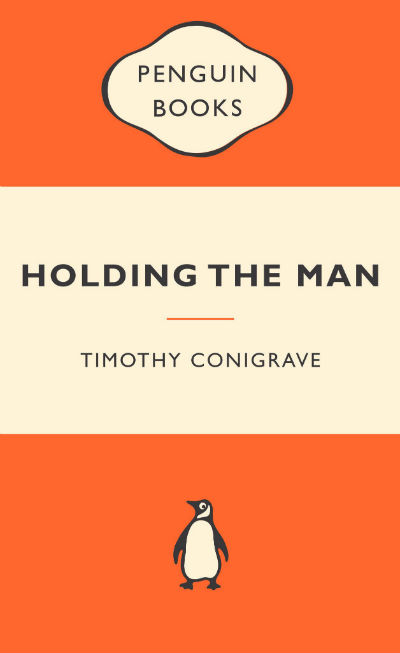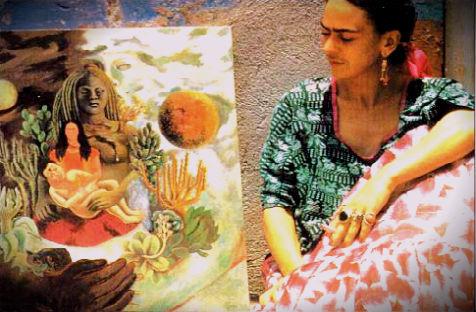Frida Kahlo in front of her painting The Love Embrace of the Universe (1949). Image via szeifertjudit.com.
Unable to able to keep your eyes off the object of your affection, increased energy, soaring heart rate and blood pressure, the urge to touch, intrusive thinking and euphoria are just some of the symptoms of the most human experience of all: love. Just as we seek out water when we are thirsty and for food when we are hungry, our bodies also seek love in order to keep us alive. It’s a matter of survival.
Long before we filled Valentine’s Day cards with passionate words, booked romantic hotel suites to enjoy heart-shaped boxes of luscious chocolate and drank champagne in spas covered with rose petals with our other halves, love has been a favourite subject with artists. In pre-historic times, stone carvings and wooly mammoth blood were used to depict the wide gamut of emotions – ranging from infatuation to lust – that take over the mind, body and soul when the cupid shoots his arrows at us.
‘Love many things for therein lies the true strength, whosoever loves much performs much and can accomplish much, and what is done in love is done well,’ Vincent Van Gogh once famously declared.
We take a look at some great works of art inspired by love, a sentiment perhaps best described by Voltaire as ‘a canvas furnished by nature and embroidered by imagination.’

1. The Meeting on the Turret Stairs (Hellelil and Hildebrand)
Painting by Sir Frederick William Burton
Inspired by an old Danish ballad, Sir Frederick William Burton’s vivid watercolour and gouache painting depicts the clandestine final embrace of tragic lovers Hellelil and Hildebrand on a turret stairway of a medieval tower. When Princess Hellelil’s father discovers the love affair between his daughter and her bodyguard Hildebrand, he considers him an unsuitable match and orders his seven sons to kill him. But Hildebrand fights back, killing the father and six of the sons before Hellelil begs for the life of her last brother to be spared. Hildebrand dies from the wounds of the violent fights and a heartbroken Hellelil passes soon after. Burton is no Tarantino, and avoids any suggestion of all the bloodshed, instead capturing a tender farewell with a poignant kiss and the lovers’ devastating lack of eye contact instead. The work was voted the favourite painting in Ireland in 2012, but because of its medium (paper) and sensitivity to light, it can only be viewed for three hours each week at the National Gallery of Ireland. Many wedding proposals have taken place in front of what has become one of the better-known works Frederic William Burton.

2. ‘Gay Bobbies’
Street art by Banksy
Banksy’s world-famous, controversial depiction of two British cops kissing passionately first popped up on the wall of a Brighton pub in the UK in 2004, where it shocked and amused locals in equal measure. The iconic image has been featured in Alfonso Cuarón’s Children of Men and came number one in a poll to determine which artwork best encapsulates British identity in 2012, beating works by artists such as Damien Hirst and Tracey Emin. The kissing coppers keep tradition with Banksy’s quintessentially cheeky and rebellious oeuvre, adding political and social commentary to the urban landscape and in this case challenging viewers’ perceptions of masculinity and the law. Since then, gay marriage has become legal in the UK and the original work by Banksy has been sold by the owner of the Alfred Prince pub, Chris Steward, through a New York gallery, after it became too costly for him to keep repairing the artwork from constant attacks. A replica stills stands outside the wall of the pub, protected by Plexiglas; it is one of Brighton’s most popular tourist attractions.

3. Taj Mahal
Mausoleum by Ustad Isa
The Taj Mahal is considered to be one of the world’s seven wonders and is most popular for immortalising one man’s love for his favourite wife. It is the finest example of Mughal architecture and India’s most popular tourist attraction, visited by an estimated 3 million people each year. Mughal Emperor Shah Jahan ensured the memory of his third wife Mumtaz Mahal would never fade away after she died giving birth to their 14th child by creating the world’s most magnificent tomb in her honour. Jahan enlisted the services of more than 20,000 labourers from across his empire, Central Asia and the Middle East as well as 1,000 elephants in a project that took about 22 years to complete. Majestic gardens, exquisite carvings of Koranic verse in calligraphy in its interior, reflecting pools and its famous mausoleum, which even takes sound into account with its acoustic design, allowing for a 28-second reverberation for prayers to Mumtaz Mahal to linger are some of the features that have inspired many Indian poets to compare the building to a piece of heaven on Earth.

4. The Embrace of the Love of the Universe
Painting by Frida Kahlo
Frida Kahlo and Diego Rivera were the protagonists of one of the greatest and most turbulent love stories the art world has ever seen. Before suffering the tragic traffic accident that left her with lifelong health problems, Kahlo had her eyes set on becoming a doctor, but bedridden she began to paint. Muralist Diego Rivera was 20 years her senior when they met and married Kahlo when she was only 22. Her greatest supporter, Rivera was Kahlo’s best critic, but also her worst enemy. ‘I suffered two grave accidents in my life… One in which a streetcar knocked me down and the other was Diego,’ Kahlo once said. Their on-again off-again relationship was punctuated by infidelity, their artistic careers, Kahlo’s inability to have children, her bisexuality, her poor health and her excruciating pain. The Embrace of the Love of the Universe is one of many of Kahlo’s paintings featuring Rivera in a work that celebrates ancient Mexican mythology and explores the complexity of the relationships between men and women on canvas. A motherly Kahlo nurtures a Rivera who sports the third eye of wisdom in his forehead, illustrating their dependency for each other as both are embraced by the Aztec Earth Mother, Cituacoatl, and the Universal Mother. All the while, Xolotl, a dog-shaped being and guardian of the underground world rests peacefully on the foreground.

5. Romeo and Juliet
Play by William Shakespeare
Written circa 1595, William Shakespeare’s Romeo and Juliet went on to become one of the most influential works in the history of theatre. It has subsequently found life in various other art forms, having since been adapted for the screen, an anime series, symphonies, musicals, ballets and operas, as well as becoming the subject matter of numerous painters, singers, sculptors and photographers. While most critics agree that it is not the legendary British author’s best play, when it comes to young love, Shakespeare’s sentimental and tragic tale of two forbidden lovers remains the ultimate masterpiece on the subject. The death of the star-crossed Veronese pair still captivates audiences more than 400 years later. At a time where young love is hardly ever associated with purity or innocence, we will always be barracking for Romeo and Juliet and wondering what could have been if they survived their premature deaths.

6. L’Age mûr (The Age of Maturity or Destiny or the Path of Life or Fatality)
Sculpture by Camille Claudel
Camille Claudel’s autobiographical sculpture L’Age mûr is a heartbreaking account of the end of her tempestuous love affair with Auguste Rodin, best known for his sculpture, The Thinker. Claudel became Rodin’s mistress, model, assistant, collaborator and muse when she was 20. The two developed an intense relationship, and were hugely influenced by each other’s work. As a sculptress who rapidly rose to fame in mid-19th century Europe, Claudel not only had to endure moral and gender prejudice in an artistic world ruled by men, but she was often overshadowed by her partnership with Rodin, who was a great admirer of her talents and recognised her as an artist in her own right. The two lived together for more than a decade, but their relationship soured following a miscarriage, a possible abortion and Rodin’s inability to leave his wife Rose Beuret. Also interpreted by critics as ‘a symbolic representation of Destiny, in which the ageing man is torn away from love, youth and life,’ L’Age mûr portrays Claudel as The Imploring Woman (L’Implorante), a vulnerable woman abandoned by her lover. Her brother, Paul Claudel, once described the work: ‘My sister Camille, imploring, humiliated, on her knees, that superb, proud creature, and what is being wrenched from her, right there before your very eyes, is her soul.’ A turning point in her career and thought to be her masterpiece, there are two different versions of the sculpture at the Musee d’Orsay in Paris. A decade later Claudel would descend into depression and madness, spending the rest of her life in psychiatric hospitals until she died in 1943.
7. Casablanca
Film by Michael Curtiz
Casablanca celebrated its 70th anniversary in 2012, sparking rumuors of a sequel being planned by Hollywood. The film starred Humphrey Bogart, Ingrid Bergman and Paul Henreid and is still as irresistible as ever; it rarely fails to make it to the top of ‘greatest films ever made’ lists with its tale of two lovers who sacrifice their love for a higher purpose. Rotten Tomatoes describes it as ‘an undisputed masterpiece and perhaps Hollywood’s quintessential statement on love and romance’. Its screenplay – adapted from the stage play by Murray Burnett and Joan Alison, Everybody Comes to Rick’s – is considered to be the best of all time by the Writers Guild of America and many experts. A memorable soundtrack and a myriad of memorable lines such as ‘We’ll always have Paris’ and ‘I think this is the beginning of a beautiful friendship,’ are just some of the elements adding to one of the most inspiring love stories to have ever hit the silver screen.
8. J’et aime…moi non plus
Song by Serge Gainsbourg and Jane Birkin
The title of what became known as one of the most erotic and romantic songs in history, J’et aime…moi non plus (‘I Love You… Me Neither’) was inspired by Salvador Dalí, who once said: ‘Picasso is Spanish. Picasso is a genius, me too. Picasso is a communist, me neither.’ The song was initially written and recorded with French siren Brigitte Bardot, who had asked her lover, pop icon Serge Gainsbourg, to pen the most beautiful love song ever heard. The saucy tune ended up upsetting Bardot’s husband at the time forcing the actress to revoke its release. The sound engineer who was present at the recording session reported there was ‘heavy petting’ in the studio at the time of recording. Gainsbourg then charmed English actress Jane Birkin, who went on to become his partner and lifelong friend, into singing it instead. ‘I only sang it because I didn’t want anybody else to sing it,’ Birkin later revealed in an interview. The song features sexual lyrics, heavy moaning and breathing, culminating in orgasmic sounds. When it was released in 1969, it became a No 1 hit throughout Europe and the first song in a language other than English to top the UK’s music charts, even though it was banned there. Many other countries including Spain, Sweden, Brazil, Italy, Poland and Portugal also banned the song. It even led to the excommunication of the record executive who released it in Italy. The lyrics are an explicit dialogue between lovers during sex reflecting ‘the desperation and impossibility of physical love.’ Since then, the original Bardot recording has also been released and artists such as Donna Summer and Madonna have covered the tune, which has also inspired duets from the likes of Brian Molko of Placebo with Asia Argento, and Cat Power with Karen Elson.

9. Holding the Man
Book by Timothy Conigrave
Timothy Conigrave’s Pulitzer Prize-winning memoir tells his true love story with John Caleo, a star footballer in an all-boys Catholic school in mid-70s Melbourne. Borrowing his title from the Aussie rules football term used for a transgression that incurs a penalty, Holding the Man was first published in 1995, shortly after Conigrave died of an AIDS-related illness. It won the United Nations Human Rights Award for Non-Fiction that year and was later included in the list of ‘100 Favourite Australian Books’ by the Australian Society of Authors. Filmmaker Tony Ayres, a friend of the author, once said in an interview: ‘If the story of the impact of AIDS in Australia was going to be told in a mainstream way, [Holding the Man] was a very good way of telling it. Because even though it’s a tragedy, it’s not a dark tragedy. It’s accessible. It’s a love story, it’s very moving and one that wouldn’t alienate a straight audience.’ The book was adapted for the stage by Tommy Murphy in 2006 to much acclaim with sell-out seasons across Australia before travelling to London’s West End.Murphy subsequently also adapted the book for the screen.
10. The Lovers: The Great Wall Walk
Performance by Marina Abramović and Ulay
In 1979, Belgrade-born Marina Abramović, one of the most celebrated performance artists in the world, spent a year living in the desert with Aboriginal Australians and her partner of 12 years, German artist Frank Uwe Laysiepen, most commonly known as Ulay. It was here that they found the inspiration for what would become their final performance, after they watched astronauts saying on TV that the only human constructions they could see from the moon were the Pyramids and the Great Wall of China. The couple, who had been performing a series called Relations at the time, decided to go to China’s most important monument, where they would walk towards each other from either end of the Wall, getting married when they met in the middle. It took Abramović and Ulay eight years to finally get permission from the Chinese government to go ahead with their creative project, and by the time each of the lovers finally got to walk their respective two and half thousand kilometres, their relationship had deteriorated. Instead of getting married, they decided to say goodbye to each other and to continue walking from there as single artists. It took them three months to reach each other, Ulay started his walk from the Gobi Desert and Abramović from the Yellow Sea. Videos, photography and diaries documented their tragically poetic journey and their brief final embrace on 3 June, 1988.





